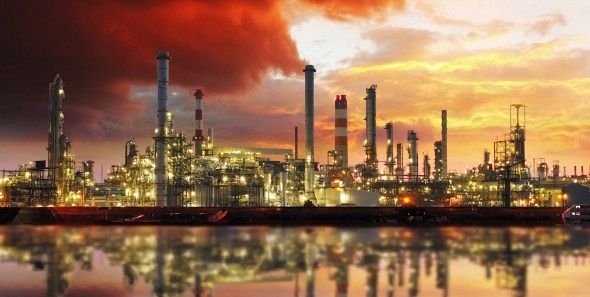Gasoline is not a pure substance, made up of identical molecules. It’s a mixture of some 270 different hydrocarbon structures (molecules made up of carbon and hydrogen atoms), chemically bonded together. It is a mixture because what we call “gasoline” is simply that fraction of petroleum that falls between two specified boiling points, chosen to assure that the resulting product is volatile enough for use in spark-ignition engines.
Gasoline can also be regarded as those hydrocarbon structures having between five and nine carbon atoms in them. Those with fewer carbons tend to be gases at room temperature (too volatile), and those with more than nine evaporate too sluggishly for use in spark-ignition engines (not volatile enough).
There are three basic kinds of hydrocarbon structures—long carbon chains, branched carbon chains, and carbon rings. Long chains are series of carbon atoms, each bonded to two or more hydrogen atoms. Branched chains are what they sound like—chains of carbon atoms that branch in one or more places. Ring compounds typically begin with a “benzene ring” of six carbon atoms, each bonded to a single hydrogen atom. In other cases, a unit such as a methyl group—a carbon bonded to three hydrogens—takes the place of one of the hydrogens bonded to the benzene ring. In that particular case, the result is called toluene (at one time, top Grand Prix racing teams in Europe carried drums of toluene for use in upgrading the highly variable local fuels).
An important property of gasoline’s many hydrocarbon structures is the knock resistance, or Octane Number, of the pure substance. Engine knock, or detonation, results when the last bits of charge to burn have been so overheated in the process that they auto-ignite and then react at the local speed of sound, creating the knocking sound we hear when shock waves hit combustion chamber surfaces.
Note that this is not pre-ignition. Pre-ignition is ignition by some hot object, before the passage of the ignition spark.
Detonation, or engine knock, is different, occurring near the end of normal combustion, after most of the charge has burned. Normal combustion is not an explosion, but is a process in which a flame front, moving at 50 to 250 feet per second, expands away from the ignition spark. The most heated parts of the fuel-air charge are the last parts to burn, out near the cylinder wall, which have been exposed to heat the longest. Heat always drives pre-flame reactions in unburned charge, but normal combustion usually consumes the charge before such reactions can proceed all the way to detonation.
But if those last bits of charge are heated long enough (through slow combustion, lugging, etc,) pre-flame reactions generate in them a population of reactive chemical fragments called radicals. When enough OH- radicals accumulate, they trigger auto-ignition and the destructive sonic-velocity combustion known as detonation.
OH- radicals form when thermal activity (molecules constantly crashing into each other at high speed) in hot unburned mixture breaks hydrogen atoms off of hydrocarbon molecules, and those hydrogens combine with single oxygen atoms. The faster OH- radicals form, the more likely knock becomes. Thus, we would expect low knock resistance from hydrocarbon structures that lose hydrogen atoms easily as temperature rises, and high knock resistance from structures that hang onto their hydrogen atoms.
Thinking about how structure would affect this, imagine a long chain molecule, whirling and thrashing, its ends hitting other molecules with velocity enhanced by rotation—a sort of whiplash effect. That action makes loss of hydrogens more likely.
Now imagine a branched chain, which, being more compact, is less able to store high energy in whipping around. And, most compact of all, the ring compounds. The most knock-resistant components of gasoline have branched-chain or ring structures.
As it turns out, long chain structures have the lowest Octane Numbers. Indeed, one of them, normal heptane (with seven carbon atoms), was adopted as the measurement standard for zero on the Octane Number scale. One of the branched-chain structures, octane (with eight carbon atoms), holds onto its hydrogen atoms so well that its Octane Number was set at 100.











24
Comment